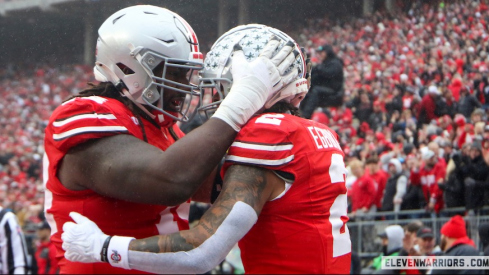
When the Buckeyes were left without a punting specialist in the wake of Johnny Townsend signing with Florida, many people (myself included) joked about how Ohio State wouldn’t be punting often anyway. Chad’s article on Wednesday about going for it on fourth down left me wondering how often Urban Meyer’s team needed its punter last year.
Looking back at 2012, what I found was surprising. Urban’s Buckeyes punted 62 times, for a 5.2 punts-per-game average. This seemed a bit high to me, so I dove a little deeper. Meyer’s teams at Florida never punted as many as 62 times in a season, and never averaged as many punts per game.
The closest the Gators under Meyer came to last year’s Ohio State total was in 2005, when Florida punted 61 times in 12 games, for a 5.1 per-game average. In the five years Meyer coached Florida (2005-10), his teams finished with punt totals (and averages) of: 61 (5.1), 53 (3.8), 37 (2.8), 45 (3.2), 34 (2.4), and 50 (3.8).
Clearly, Meyer’s teams typically don’t punt very often. The Gators averaged less than a punt per quarter in five of his six years in Gainesville, with an incredible 2.4 per game in 2009. Punting only once per half must have been cooler than seeing Genesis perform “Supper’s Ready” live back in the day.
The Buckeyes did manage to improve last year over Luke Fickell’s 2011 squad. Fickell’s year at the helm produced 72 punts in 13 games, an average of 5.5 punts per game. Those numbers exclude arm punts and blocked punts.
“So what,” you say. “Hasn’t Ohio State long been known for punting and playing defense? Isn’t Jim Tressel the man known for saying ‘the punt is the most important play in football?’”
Although the sweater vested one is indeed a punting proponent, a look back is a little surprising. You’d have to go all the way back to 2004 to find a Jim Tressel team that punted more often than last year’s Ohio State team under Meyer. That 2004 team punted 67 times in 12 games for an average of 5.6. In 2003, Tressel’s bunch punted a whopping 82 times — 6.3 per game.
That’s it. The rest of Tressel’s career at Ohio State featured fewer punts per game than Meyer’s 2012 team. Throwing out 2003 and 2004, Tressel’s teams punted 48 (4.4 per game), 60 (4.3), 43 (3.6), 49 (3.8), 54 (4.2), 60 (4.6), 62 (4.8), and 46 (3.5) times. The man known to be a punting aficionado led three different OSU teams that punted fewer than once per quarter.
| Year | total punts | avg. per game | coach |
|---|---|---|---|
| 2012 | 62 | 5.2 | Meyer |
| 2011 | 72 | 5.5 | Fickell |
| 2010 | 46 | 3.5 | Tressel |
| 2009 | 62 | 4.8 | Tressel |
| 2008 | 60 | 4.6 | Tressel |
| 2007 | 54 | 4.2 | Tressel |
| 2006 | 49 | 3.8 | Tressel |
| 2005 | 43 | 3.6 | Tressel |
| 2004 | 67 | 5.6 | Tressel |
| 2003 | 82 | 6.3 | Tressel |
| 2002 | 60 | 4.3 | Tressel |
| 2001 | 48 | 4.4 | Tressel |
| Totals | 705 | 4.6 | --- |
The coach we associate with loving him some punting averaged 4.5 punts per game over his 10 years in Columbus — nearly a full punt per game less than Meyer’s squad from last season.
Ohio State's 5.2 punts-per-game average in all competitions was fifth in the B1G in 2012, ranking behind Michigan (3.5), Penn State (4.3), Nebraska (4.4), and Northwestern (4.9). Minnesota (5.3) and Purdue (5.4) were just behind the Buckeyes, who punted one less time per game than Michigan State. The Spartans were last in the B1G with 6.2 punts per game. In B1G games alone, Ohio State improved to third in the conference, trailing only Michigan (3.5) and Penn State (4.4). Indiana brought up the rear with 6.8 punts per game in league play.
A closer inspection shows some anomalies that helped lead to last year’s lofty total. Of the 62 punts launched last season, half of them (31) came in just four games — at Wisconsin, and home to Miami (OH), UAB, and California. The Buckeyes punted nine times in Madison, eight times against Cal, and seven times each against UAB and Miami.
Since three of those totals came in the first four games, it’s safe to assume that there were some growing pains in learning the offense. Certainly there were some execution problems, as well as some key dropped passes in those non-conference games.
In the opener against Miami, the Buckeyes punted on their first four possessions. You may recall that Ohio State trailed 3-0 after the first quarter. At home. Against Miami. You probably didn’t really start to get nervous before the Buckeyes got rolling, but you weren’t exactly thrilled at what you were seeing, either. My how things changed as the season wore on.
| Year | School | Total Punts | Avg. Per Game |
|---|---|---|---|
| 2012 | OSU | 62 | 5.2 |
| 2010 | FL | 50 | 3.8 |
| 2009 | FL | 34 | 2.4 |
| 2008 | FL | 45 | 3.2 |
| 2007 | FL | 37 | 2.8 |
| 2006 | FL | 53 | 3.8 |
| 2005 | FL | 61 | 5.1 |
| Totals | --- | 342 | 3.7 |
Once Ohio State got into conference play, the offense moved much more smoothly overall. In the eight B1G games, Ohio State punted four times or fewer on five occasions, including only three each against Michigan and Illinois. There were five punts in the Purdue game, in which Braxton Miller was shelved for a good chunk of minutes due to injury. The Buckeyes punted six times in Happy Valley. The nine times at Wisconsin represented an outlier.
The Buckeyes averaged 4.8 punts per game in B1G play last year, which is a dramatic improvement on the 6.0 per game during the non-conference slate. The Wisconsin game was an aberration for both teams. The Badgers punted eight times in that November meeting, and Philly Brown housed the third of those for the game’s first score.
What can we expect moving forward?
I think we’ll see the numbers move closer to Urban Meyer’s Florida totals and averages, although we probably won’t see the 2.4 punts per game he had in 2009 or the 2.8 the Gators averaged in 2007. It might not even reach the 3.5 per game his Florida teams averaged over his six years in Gainesville. But I do think it will trend closer to four punts per game than the 5-plus that we’ve seen at Ohio State the last two years.
Tom Herman’s offense is in year two. The installation is much closer to completion now and only the freshmen will be learning it on the fly. In addition, the return of four starters on the offensive line should help. Braxton Miller’s continued development as both a passer and a runner will also contribute to fewer punts. Finally, more playmaking at wide receiver is another aspect that can reduce the need for the punt team to take the field.
But Drew Basil will have to be sharp no matter how many times he's called upon to boot the ball away, whether it's twice or nine times. Special teams plays can turn a game, and no one knows that better than Meyer. His teams have never lost a game in which they've blocked a punt.
The punt may be the most important play in football, but not having to do it due to offensive success is fine by me.

